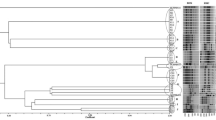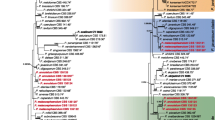Abstract
Penicillium crustosum is an important and panglobal contaminant of lipid- and protein-rich foods and feeds. Although it is infrequent in extremely cold environments, we isolated a high number of P. crustosum strains from Arctic coastal, but particularly, subglacial environments in Svalbard, Norway. P. crustosum is extremely consistent in its phenotypic properties, including morphology, physiology, and secondary metabolite production. However, some Arctic isolates differed from other Arctic and non-Arctic strains in their weak growth on creatine and in the production of the secondary metabolite andrastin A. In this study, we characterized genetic variability of P. crustosum strains originating from different Arctic and non-Arctic environments using amplified fragment length polymorphism (AFLP) and, in addition, M13 minisatellite fingerprinting and partial β-tubulin gene sequencing. Most of the Arctic strains (85%) showed a relatively low variability and polymorphism level. They produced nine different AFLP genotypes grouped into two clusters in accordance with glacier origin and creatine utilization. The rest of the Arctic isolates and isolates from various non-Arctic environments displayed a much greater degree of genetic variability. It seems that in stressful glacial environment low microbial genetic variation is represented by only a few adapted genotypes that were not recovered from nonpolar environments.



Similar content being viewed by others
References
Abyzov, SS (1993) Microorganisms in the Antarctic ice. In: Friemann, EI (Ed.) Antarctic Microbiology, Wiley-Liss, Inc., New York, pp 265–295
Bruford, MW, Wayne, RK (1993) Microsatellites and their application to population genetic studies. Curr Opin Genet Dev 3: 939–943
Castella, G, Larsen, TO, Cabanes, J, Schmidt, H, Alboresi, A, Niessen, L, Färber, P, Geisen, R (2002) Molecular characterization of ochratoxin A producing strains of the genus Penicillium. Syst Appl Microbiol 25: 74–83
De Barros Lopes, M, Rainieri, S, Henschke, PA, Langridge, P (1999) AFLP fingerprinting for analysis of yeast genetic variation. Int J Syst Bacteriol 49: 915–924
Denning, DW, Clemons, KV, Hanson, LH, Stevens, DA (1990) Restriction endonuclease analysis of total cellular DNA of Aspergillus fumigatus isolates of geographically and epidemiologically diverse origin. J Infect Dis 162: 1151–1158
Ekström, G, Nettles, M, Abers, GA (2003) Glacial earthquakes. Science 302: 622–624
Fahnestock, M (2003) Geophysics: glacial flow goes seismic. Science 302: 578–579
Foght, J, Aislabie, J, Turner, S, Brown, CE, Ryburn, J, Saul, DJ, Lawson, W (2004) Culturable bacteria in subglacial sediments and ice from two southern hemisphere glaciers. Microb Ecol 47: 329–340
Frisvad, JC (1985) Creatine sucrose agar, a differential medium for mycotoxin producing terverticillate Penicillium species. Lett Appl Microbiol 1: 109–113
Frisvad, JC (1993) Modifications on media based on creatine for use in Penicillium and Aspergillus taxonomy. Lett Appl Microbiol 16: 154–157
Frisvad, JC (2004) Chemical diversity of psychrotolerant fungi. In: Watanabe, MM, Suzuki, K, Seki, T (Eds.) Innovative Roles of Biological Resources Centers, Society for Culture Collections and Worlds Federation of Culture Collections, Tsukuba, pp 165–167
Frisvad, JC, Lund, F, Elmholt, S (2005) Ochratoxin A producing Penicillium verrucosum isolates from cereals reveal large AFLP fingerprinting variability. J Appl Microbiol 98: 684–692
Frisvad, JC, Samson, RA (2004) Polyphasic taxonomy of Penicillium subgenus Penicillium. A guide to identification of food and air-borne terverticillate Penicillia and their mycotoxins. Stud Mycol 49: 1–173
Frisvad, JC, Thrane, U (1987) Standardized high-performance liquid chromatography of 182 mycotoxins and other fungal metabolites based on alkylphenone retention indices and UV–VIS spectra (diode array detection). J Chromatogr 404: 195–214
Frisvad, JC, Thrane, U (1993) Liquid column chromatography of mycotoxins. J Chromatogr Libr 54: 253–372
Gerrits van den Ende, AHG, de Hoog, GS (1999) Variability and molecular diagnostics of the neurotropic species Cladophialophora bantiana. Stud Mycol 43: 151–162
Glass, NL, Donaldson, GC (1995) Development of primer sets designed for use with the PCR to amplify conserved genes from filamentous ascomycetes. Appl Environ Microbiol 61: 1323–1330
Gunde-Cimerman, N, Sonjak, S, Zalar, P, Frisvad, JC, Diderichsen, B, Plemenitaš, A (2003) Extremophilic fungi in Arctic ice: a relationship between adaptation to low temperature and water activity. Phys Chem Earth Part B 28: 1273–1278
Ivanushkina, NE, Kochkina, GA, Ozerskaya, SM (2005) Fungi in ancient permafrost sediments of the Arctic and Antarctic regions. In: Castello, JD, Rogers, SO (Eds.) Life in Ancient Ice, Princeton University Press, Princeton, pp 127–139
Kis-Papo, T, Oren, A, Nevo, E (2003) Genetic diversity of filamentous fungi under hypersaline stress in the Dead Sea. In: Nevo, E, Oren, A, Wasser, SP (Eds.) Fungal Life in the Dead Sea, Gantner Verlag, Ruggell, pp 314–332
Kumar, S, Tamura, K, Nei, M (2004) MEGA3: Integrated software for molecular evolutionary genetics analysis and sequence alignment. Brief Bioinformatics 5: 150–163
Kure, CF, Abeln, ECA, Holst-Jensen, A, Skaar, I (2002) Differentiation of Penicillium commune and Penicillium palitans isolates from cheese and indoor environments of cheese factories using M13 fingerprinting. Food Microbiol 19: 151–157
Kure, CF, Skaar, I, Holst-Jensen, A, Abeln, ECA (2003) The use of AFLP to relate cheese-contaminating Penicillium strains to specific points in the production plants. Int J Food Microbiol 83: 195–204
Leissner, CEW, Niessen, ML, Vogel, RF (1997) Use of the AFLP technique for the identification and discrimination of Fusarium graminearum. Cer Res Com 25: 555–556
Lund, F, Nielsen, AB, Skouboe, P (2003) Distribution of Penicillium commune isolates in cheese dairies mapped using secondary metabolite profiles, morphotypes, RAPD and AFLP fingerprinting. Food Microbiol 20: 725–734
Ma, L, Catranis, CM, Starmer, WT, Rogers, SO (1999) Revival and characterization of fungi from ancient polar ice. Mycologist 13: 70–73
Ma, L, Rogers, SO, Catranis, CM, Starmer, WT (2000) Detection and characterization of ancient fungi entrapped in glacial ice. Mycologia 92: 286–295
Majer, D, Mithen, R, Lewis, BG, Vos, P, Oliver, RP (1996) The use of AFLP fingerprinting for the detection of genetic variation in fungi. Mycol Res 100: 1107–1111
Männistö MK, Häggblom MM (2006) Characterization of psychrotolerant heterotrophic bacteria from Finnish Lapland. Syst Appl Microbiol 29: 229–243
McRae, CF, Hocking, AD, Seppelt, RD (1999) Penicillium species from terrestrial habitats in the Windmill Islands, East Antarctica, including a new species, Penicillium antarcticum. Polar Biol 21: 97–111
Meyer, W, Mitchell, TG, Freedman, EZ, Vilgalys, R (1993) Hybridization probes for conventional DNA fingerprinting used as single primers in the polymerase chain reaction to distinguish strains of Cryptococcus neoformans. J Clin Microbiol 31: 2274–2280
Montiel, D, Dickinson, MJ, Lee, HA, Dyer, PS, Jeenes, DJ, Roberts, IN, James, S, Fuller, LJ, Matsuchima, K, Archer, DB (2003) Genetic differentiation of the Aspergillus section Flavi complex using AFLP fingerprints. Mycol Res 107: 1427–1434
Pavlíček, A, Hrda, S, Flegr, J (1999) FreeTree—freeware program for construction of phylogenetic trees on the basis of distance data and for bootstrap/jackknife analysis of the trees robustness. Application in the RAPD analysis of genus Frenkelia. Folia Biol (Praha) 45: 97–99
Perrone, G, Mulè, G, Susca, A, Battilani, P, Pietri, A, Logrieco, A (2006) Ochratoxin A production and amplified fragment length polymorphism analysis of Aspergillus carbonarius, Aspergillus tubingensis, and Aspergillus niger strains isolated from grapes in Italy. Appl Environ Microbiol 72: 680–685
Pitt, JI (1979) Penicillium crustosum and P. simplicissimum, the correct names for two common species producing tremorgenic mycotoxins. Mycologia 71: 1166–1177
Pitt, JI, Hocking, AD (1999) Fungi and Food Spoilage. Aspen Publishers, Inc., Gaithersburg
Radišek, S, Jakše, J, Simončič, A, Javornik, B (2003) Characterization of Verticillium alboatrum field isolates using pathogenicity data and AFLP analysis. Plant Dis 87: 633–638
Raper, CA, Raper, JR, Miller, RE (1972) Genetic analysis of the life cycle of Agaricus bisporus. Mycologia 64: 1088–1117
Rosendahl, S, Taylor, JW (1997) Development of multiple genetic markers for studies of genetic variation in arbuscular mycorrhizal fungi using AFLP™. Mol Ecol 6: 821–829
Sampaio, JP, Gadanho, M, Santos, S, Duarte, FL, Pais, C, Fonseca, A, Fell, JW (2001) Polyphasic taxonomy of the basidiomycetous yeast genus Rhodosporidium: Rhodosporidium kratochvilovae and related anamorphic species. Int J Syst Evol Microbiol 51: 1–11
Samson, RA, Hoekstra, ES, Frisvad, JC, Filtenborg, O (2002) Introduction to Food- and Airborne Fungi. Centraalbureau voor Schimmelcultures, Utrecht
Samson, RA, Hoekstra, ES, Lund, F, Filtenborg, O, Frisvad, JC (2002) Methods for the detection, isolation and characterization of food-borne fungi. In: Samson, RA, Hoekstra, ES, Frisvad, JC, Filtenborg, O (Eds.) Introduction to Food- and Airborne Fungi, Centraalbureau voor Schimmelcultures, Utrecht, pp 283–297
Samson, RA, Seifert, KA, Kuijpers, AFA, Houbraken, JAMP, Frisvad, JC (2004) Phylogenetic analysis of Penicillium subgenus Penicillium using partial β-tubulin sequences. Stud Mycol 49: 175–200
Savelkoul, PHM, Aarts, HJM, de Haas, J, Dijkshoorn, L, Duim, B, Otsen, M, Rademaker, JLW, Schouls, L, Lenstra, JA (1999) Amplified-fragment length polymorphism analysis: the state of an art. J Clin Microbiol 37: 3083–3091
Schmidt, H, Niessen, L, Vogel, RF (2004) AFLP analysis of Fusarium species in the section Sporotrichiella—evidence for Fusarium langsethiae as a new species. Int J Food Microbiol 95: 297–304
Smedsgaard, J (1997) Micro-scale extraction procedure for standardized screening of fungal metabolite production in cultures. J Chromatogr 760: 264–270
Sonjak, S, Frisvad, JC, Gunde-Cimerman, N (2005) Comparison of secondary metabolite production by Penicillium crustosum strains, isolated from Arctic and other various ecological niches. FEMS Microbiol Ecol 53: 51–60
Sonjak, S, Frisvad, JC, Gunde-Cimerman, N (2006) Penicillium mycobiota in Arctic subglacial ice. Microb Ecol 52: 207–216
Tuthill, DE (2004) Genetic variation and recombination in Penicillium miczynskii and Eupenicillium species. Mycol Prog 3: 3–12
Van der Lee, T, de Witte, I, Drenth, A, Alfonso, C, Govers, F (1997) AFLP linkage map of the Oomycete Phytophthora infestans. Fungal Genet Biol 21: 278–291
Vos, P, Hogers, R, Bleeker, M, Reijans, M, van der Lee, T, Hornes, M, Frijters, A, Pot, J, Peleman, J, Kuiper, M, Zabeau, M (1995) AFLP: a new technique for DNA fingerprinting. Nucleic Acids Res 23: 4407–4414
Williams, JGK, Kubelik, AR, Livak, KJ, Rafalski, JA, Tingey, SV (1990) DNA polymorphisms amplified by arbitrary primers are useful as genetic markers. Nucleic Acids Res 18: 6531–6535
Acknowledgments
We thank Sebastjan Radišek for introductory work with the AFLP technique. The sampling was possible due to Large Scale Facility (LSF) Funds.
Author information
Authors and Affiliations
Corresponding author
Rights and permissions
About this article
Cite this article
Sonjak, S., Frisvad, J.C. & Gunde-Cimerman, N. Genetic Variation Among Penicillium crustosum Isolates from Arctic and other Ecological Niches. Microb Ecol 54, 298–305 (2007). https://doi.org/10.1007/s00248-006-9202-1
Received:
Revised:
Accepted:
Published:
Issue Date:
DOI: https://doi.org/10.1007/s00248-006-9202-1




